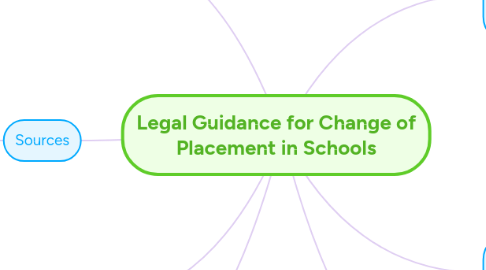
1. The IEP team makes a decision about the child’s needs and the special education program. Placements will be individualized and based on the child's unique IEP.
1.1. Do the parents have a say?
1.1.1. Yes
1.2. Are their any rules about placement decisions?
1.2.1. Based the child’s unique needs as documented in the IEP
1.2.2. Determined at least once a year
1.2.3. As close to the child’s home as possible so the child can be educated in the school he would attend if he was not disabled.
1.3. The child's placement may not be based on..
1.3.1. The child’s disability category or label or severity of the disability (i.e., children with autism are placed in a class with other children with autism)
1.3.2. The school’s service delivery model (i.e., all children with learning disabilities receive “pull out’ or resource services)
1.3.3. The availability of special education and related services, staff location, or school district convenience.
2. The Individuals with Disabilities Education Act requires that schools provide a continuum of alternative placements for children with disabilities.
2.1. The continuum of alternative placements refers to places where children receive special education services. Placements are on a continuum, from least to most restrictive. The child’s placement may be in...
2.1.1. A regular class, with needed supplementary aids and services
2.1.2. Home
2.1.2.1. A hospital or other private institution
2.1.3. A special class where all children in the class receive special education services for some or all of the day.
3. After a child with a disability has been removed from his or her current placement for 10 school days in the same school year, the school system must provide services to the student during any subsequent days of removal
3.1. The “default” placement during an appeal now is the IAES. IDEA states that the child must remain in the IAES chosen by the IEP team until the hearing officer makes his or her decision on the appeal or the time period for the child’s removal expires—whichever comes first—unless the parent and the SEA or LEA agree otherwise.
4. What can the parents do if they disagree with the placement decision?
4.1. File a state complaint
4.2. Facilitated IEP Meeting
4.2.1. IEP Review
4.3. Mediation
4.4. Due Process
4.5. Parental rights must be respected and addressed in matters relating to evaluation an IEP development.
5. Sources
5.1. Placement, Short-and-Sweet | Center for Parent Information and Resources. (n.d.). Retrieved February 02, 2016, from http://www.parentcenterhub.org/repository/placement-overview/
5.2. Essex, N. L. (2012). School law and the public schools: A practical guide for educational leaders. Upper Saddle River, NJ: Pearson Eduction.
5.3. The Wrightslaw Way. (n.d.). Retrieved February 03, 2016, from http://www.wrightslaw.com/blog/changing-placement-helpful-legal-references/
6. Why would you change a placement?
6.1. Long-Term suspension
6.1.1. Students with disabilities should not be disciplined for behavior that is associated with their known disabilities.
6.1.1.1. If the group determines that the child’s misconduct was the direct result of the LEA’s failure to implement the child’s IEP, the “LEA must take immediate steps to remedy those deficiencies.”
6.1.1.1.1. Unless the behavior involved weapons, drugs, or serious bodily injury—called special circumstances—the child would be returned to the placement from which he or she was removed as part of the disciplinary action. However, the parent and LEA can agree to a change of placement as part of the modification of the behavioral intervention plan.

